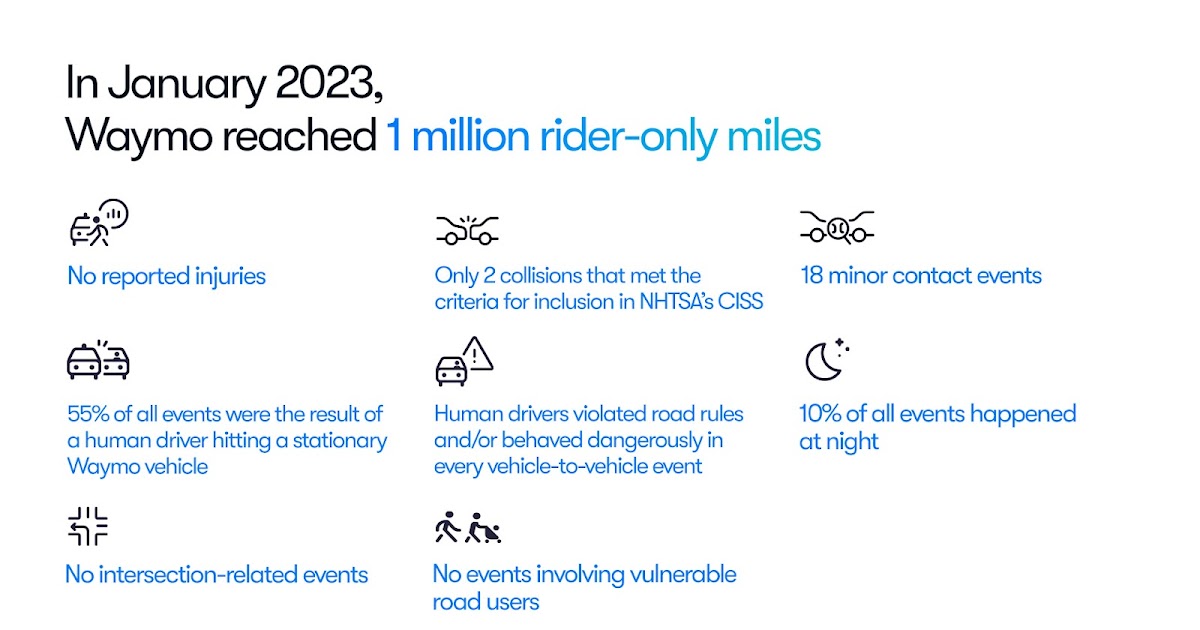Waymo has achieved many global industry firsts. Each time we delight our riders and deliver on our mission safely, we are proudest. In January, we accomplished another first: we exceeded one million miles on public roads with no human behind the wheel. To put this into perspective, this equates to 40 trips around the Earth, or over 80 years of driving for the average American. But this number is not a meaningful measure of progress, without context. What’s more important is our safety performance over the course of these one million rider-only miles that demonstrates the safety benefits of the Waymo Driver. We’re sharing this safety performance data today to both acknowledge this next step on our journey, and to encourage greater transparency across the industry.
We drove our first one million rider-only miles across multiple U.S. cities, including the densest parts of San Francisco and Phoenix , where we’re serving riders around the clock. The Waymo Driver safely navigated around crowds of pedestrians, cyclists, double parked cars, emergency vehicles, construction zones, and lane closures 24/7 — all without a human in the driver’s seat. To provide a more in-depth look into the performance of the Waymo Driver and where it stands compared to human driving, we’ve published a research paper that summarizes the contact events that we experienced during the first one million miles of our rider-only operations.
The results provide further evidence that the Waymo Driver is effective today in reducing injuries and fatalities on the road. Some of the findings include:
- There were no reported injuries, and only two collisions that met the criteria for inclusion in NHTSA’s database for car crashes, called Crash Investigation Sampling System (“CISS”). This nationally representative collision database consists of crashes that were reported to the police and in which at least one vehicle had to be towed away. In the more severe of the two collisions, a Waymo vehicle was hit from behind by another car whose driver was looking at their cell phone while approaching a red light.
- There were an additional 18 minor contact events that did not meet CISS criteria — such as another car backing out of a parking space into a stationary Waymo waiting to pick up a rider, and a portable plastic sign stand getting blown by the wind and making contact with our vehicle (neither of which resulted in any damage). While such events aren’t reflected in most human crash databases, we have included them for greater transparency.
- Overall, more than half of all contact events were the result of a human driver hitting a stationary Waymo vehicle.
- None of the collisions or contact events happened at intersections, where most injury-causing and fatal collisions usually take place, nor involved vulnerable road users such as pedestrians and cyclists.
- Despite 24/7 driving across major U.S. cities, Waymo experienced no collisions at all of the types that are responsible for 94% of fatal collisions in NHTSA’s crash investigation database (FARS).
- Every vehicle-to-vehicle event involved one or more road rule violation and/or dangerous behaviors on the part of the human drivers in the other vehicle.
- While we operate in rider-only mode around the clock, we experienced a lower frequency of contact events between 10 PM and 6 AM. This is unsurprising, as nighttime driving environments tend to be less crowded — for example, we encountered 65% fewer pedestrians , 85% fewer cyclists, and 83% fewer motorcyclists in San Francisco during late night hours — and is consistent with human crash data. Some studies on human driving suggest though that despite a lower rate of collisions overall, there’s a higher rate of fatalities at night — likely due to increased risk factors such as alcohol, fatigue, and speeding. The Waymo Driver in turn eliminates these risk factors from its operation of the vehicle entirely.
Comparing the Waymo Driver’s performance to human driving over time is an important method of safety assessment that can provide further validation of the results. However, for this comparison to be valid, it is important to apply the same requirements to AV and human crash reporting. Waymo is in the unique position to be able to identify even very minor contact events, many of which are required to be reported by AV companies to regulatory agencies. On the other hand, human crash databases include primarily high-severity incidents and lack information on minor collisions that are often unreported. Establishing a robust baseline of road incidents caused by humans is key and requires appropriate calibration of the human data. For example, one objective benchmark for safety could be comparing only events that would typically be reported by human drivers — such as the two police reportable collisions from our first 1 million rider-only miles. Likewise, to make meaningful comparisons between AV systems, it’s important to account for variables in driving conditions that may impact safety, such as road types, traffic and pedestrian density, weather, and hours of operations.
The results we’ve shared today, in combination with our previously reported data , fatal crash reconstruction , and collision avoidance testing studies, underscore the Waymo Driver’s ability to reduce injuries and fatalities on the road. Today we rely on data from tens of millions of miles we’ve driven on public roads within the last decade, including now over one million rider-only miles, along with tens of billions of miles from our state-of-the-art simulation infrastructure. In the future, we’re confident that our commercial progress and performance will provide even more evidence of the Waymo Driver’s safety benefits.
For autonomous driving technology to gain public acceptance, we work everyday to earn the trust of the public. We believe that transparency and accountability are paramount for AVs’ long-term success, and we’ll continue to share meaningful safety information, and encourage others to do the same.
